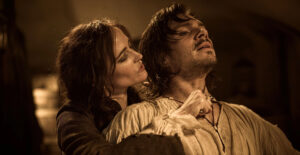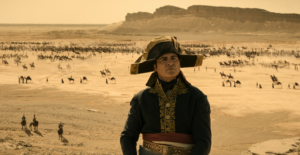Le Comte de Monte-Cristo
(The Count of Monte-Cristo)
Meilleurs Costumes – Césars
Meilleurs Décors – Césars
César des lycéens – Césars
2024

FR EN
Nombreuses sont les adaptations du plus célèbre vengeur français, inspirateur officieux des célèbres figures de Batman ou de Zorro. Des adaptations le plus souvent sous le format télévisuel dû à la longueur d’un récit bien épais. Une fresque vengeresse sur plus d’une décennie et que les réalisateurs Matthieu Delaporte et Alexandre De La Patellière distillent ici en un seul et vibrant long-métrage.
Edmond Dantès, est un homme venu du peuple et qui parvient par son courage et ses efforts à se hisser capitaine de bateau. Une ascension sociale rare dont les jalousies vont le condamner à bien pire que la mort : l’oubli. Faussement accusé de Bonapartisme et arrêté le jour de son mariage, il est enfermé et déclaré aux yeux de tous comme mort. Dans les cellules de l’île d’If, Edmond Dantès fait la rencontre de L’abbé Faria qui lui confie les secrets de l’île de Monte-Cristo où repose un énorme trésor, et la possibilité s’il s’échappe, d’assouvir sa vengeance.
Tout en étant fidèle au récit, les deux réalisateurs parviennent à rendre spectaculaire un récit pourtant basé sur une vengeance patiemment orchestrée. Rien n’est perdu, ni le charme ni la langue que les auteurs adaptent avec une subtile modernité, alliant théâtralité et romanesque. Le film ne souffre d’aucune longueur tant les tableaux s’enchaînent avec un redoutable montage. Même si on peut y voir une industrialisation du genre dans la continuité des « Trois mousquetaires », ce « Comte de Monte-Cristo » attrape avec bien plus de poésie la dramaturgie d’une époque.
On ne peut évidemment ausculter le film sans souligner la puissance de jeu de Pierre Niney qui insuffle à Dantès une épaisseur où se côtoient force et faiblesses, une prouesse de jeu jusque-là peu explorée dans les différentes adaptations. On relèvera également une relecture bienvenue de la relation entre Haydée et Edmond, une relation ambiguë dans le livre qui apparaît ici et avec plus de force comme une relation père-fille. Une relecture qui, même si elle frôle le manichéisme, offre une très belle adaptation des six volumes d’une œuvre colossale.
C’est un film de spectacle qui ne s’oublie pas dans une recherche d’esthétique hollywoodienne et propose à l’inverse de l’adaptation récente des « Trois mousquetaires », une lecture poétique et sensible. Même s’il ne fait que frôler le génie de mise en scène d’un Rappeneau (« Cyrano de Bergerac », « Le Hussard sur le toit »), ce « Comte de Monte-Cristo » saura ravir les friands de film d’époque, d’aventure et de spectacle.
There have been many adaptations of France’s most famous avenger, the unofficial inspiration for Batman and Zorro. Most of these adaptations have been made for television, due to the sheer length of the original story. This time, directors Matthieu Delaporte and Alexandre De La Patellière bring this decade-long tale of vengeance to life in a single, vibrant feature film.
Edmond Dantès is a man of the people who, through courage and hard work, succeeds in becoming a ship’s captain. A rare social achievement whose envy condemned him to a fate far worse than death: oblivion. Falsely accused of Bonapartism and arrested on the day of his wedding, he was locked up and declared dead for all to see. In the prison cells of Château d’If, Edmond Dantès meets Abbé Faria, who tells him the secrets of the Monte-Cristo Island, where a huge treasure lies, and the chance to exact his revenge if he manages to get away.
While remaining true to the story, the two directors succeed in making a story based on carefully orchestrated revenge spectacular. Nothing is lost, neither the charm nor the idiom, which the filmmakers adapt with a subtle modernity, combining theatricality and romance. The film is never too long, as the scenes flow into one another with terrific editing. Although it might be seen as an industrialization of the genre in the wake of “The Three Musketeers”, this “Count of Monte Cristo” captures the dramaturgy of an era far more poetically.
Of course, we can’t review the film without highlighting the power of Pierre Niney’s performance, which imbues Dantès with a depth that combines strength and weakness, an acting prowess previously little explored in the various adaptations. There’s also a welcome new take on the relationship between Haydée and Edmond, an ambiguous one in the book that appears here more strongly as a father-daughter relationship. A fresh interpretation which, though bordering on Manicheanism, offers a very good adaptation of the six volumes of this massive work of literature.
This is a spectacular picture that doesn’t lose itself in a quest for Hollywood aesthetics and, unlike the recent adaptation of “The Three Musketeers”, offers a poetic and sensitive portrayal. While it may only come close to the directing genius of Rappeneau (“Cyrano de Bergerac”, “The Horseman on the Roof”), “The Count of Monte Cristo” will surely delight all fans of period films, adventure and entertainment.

